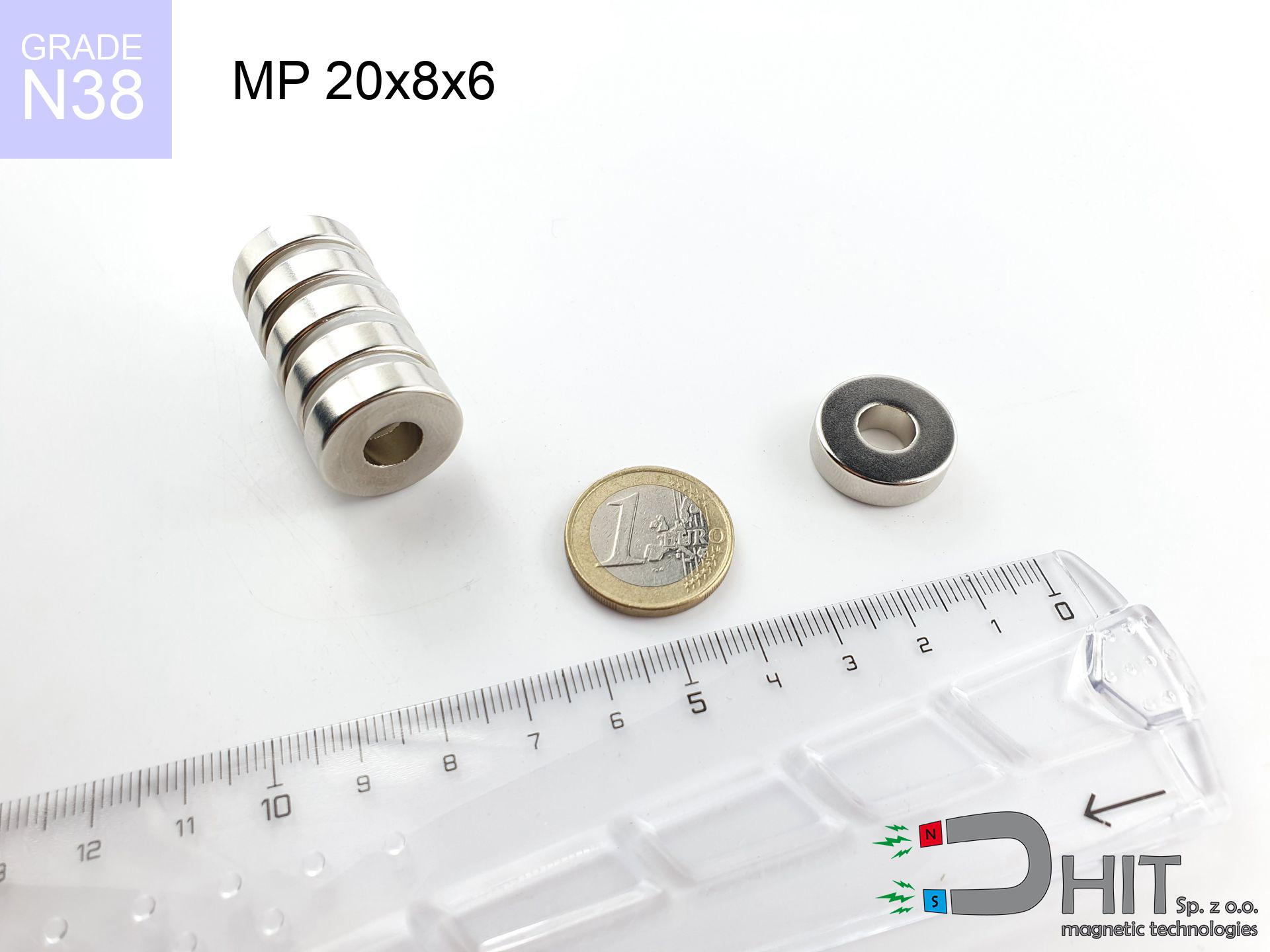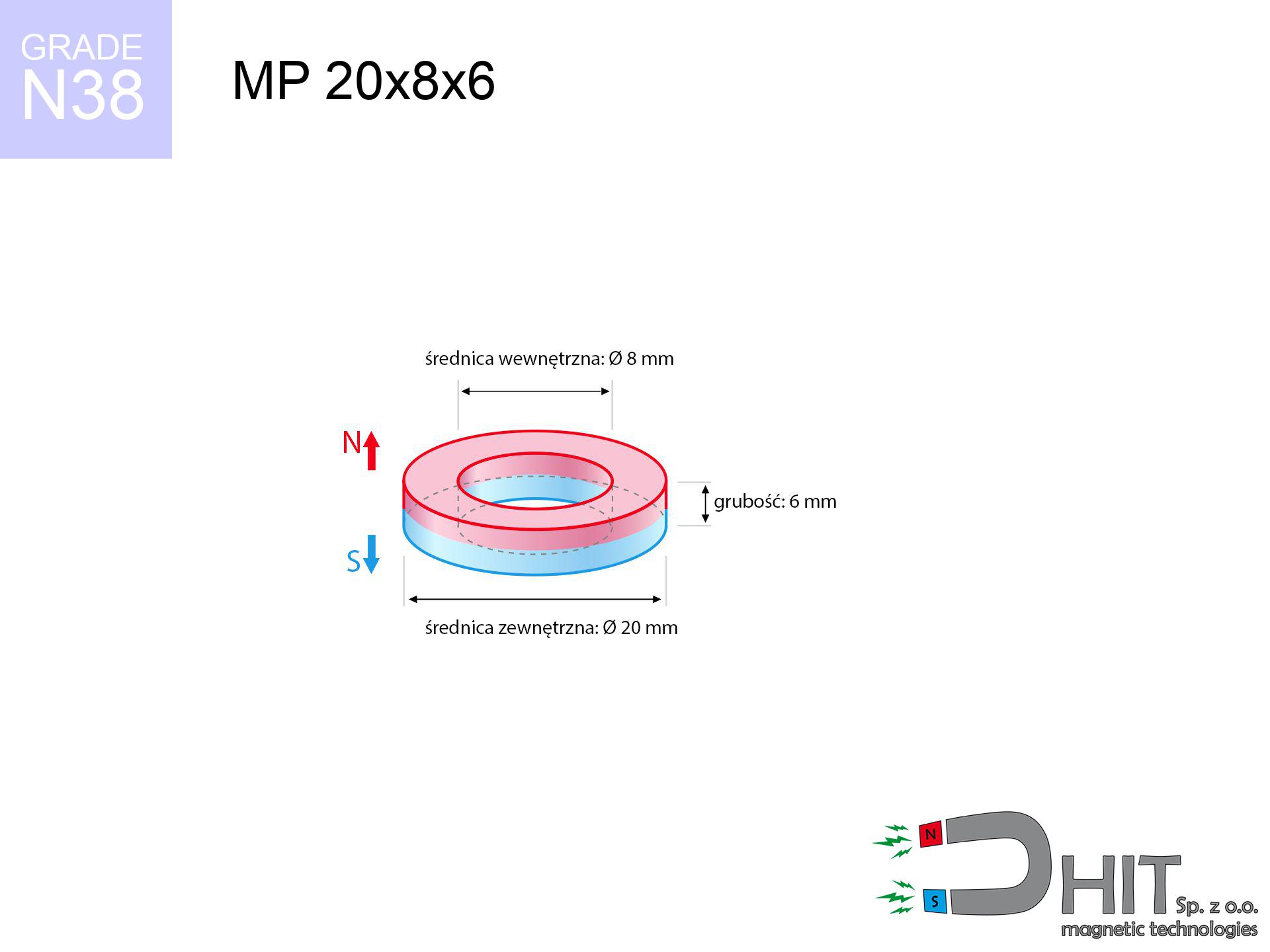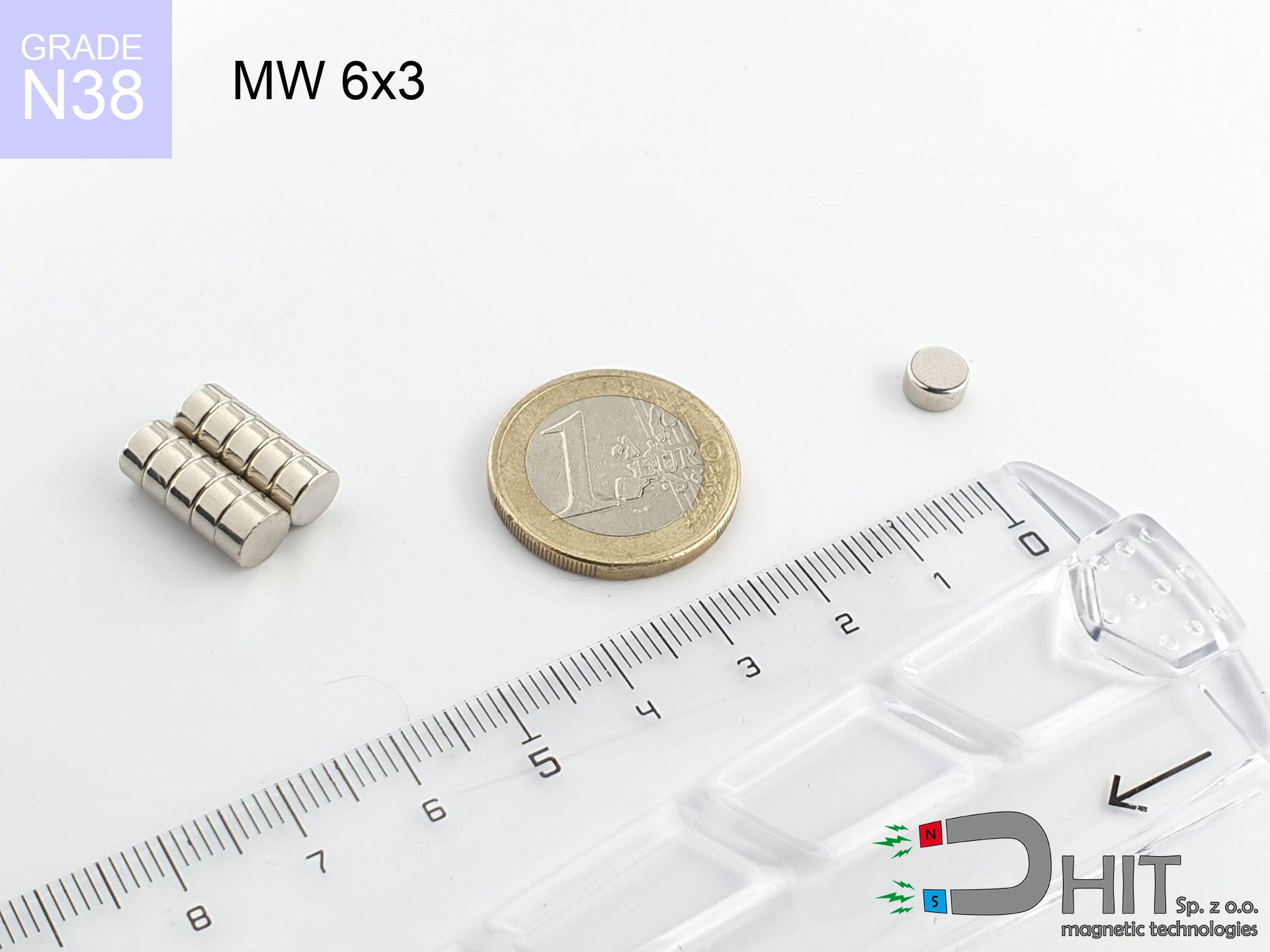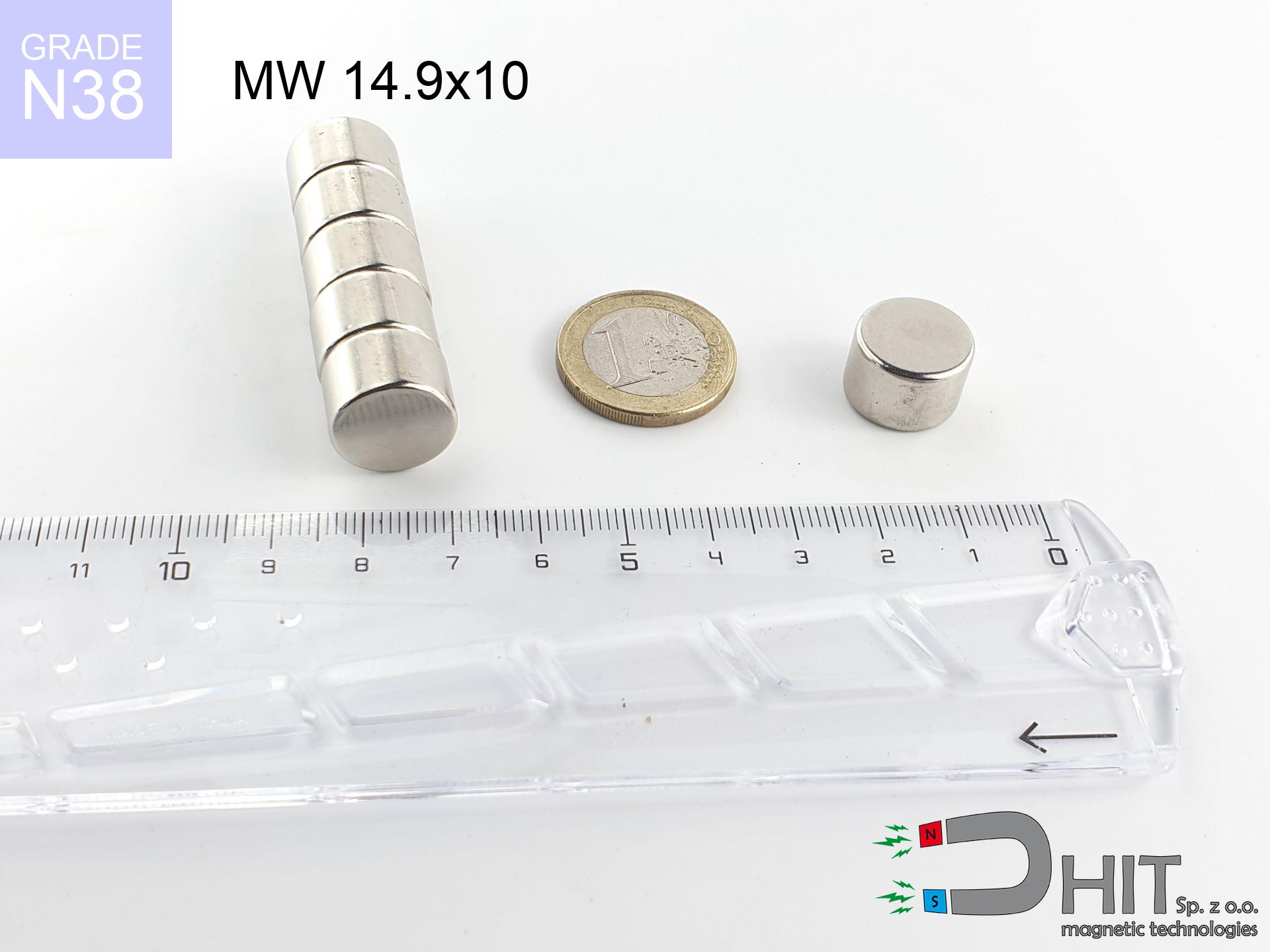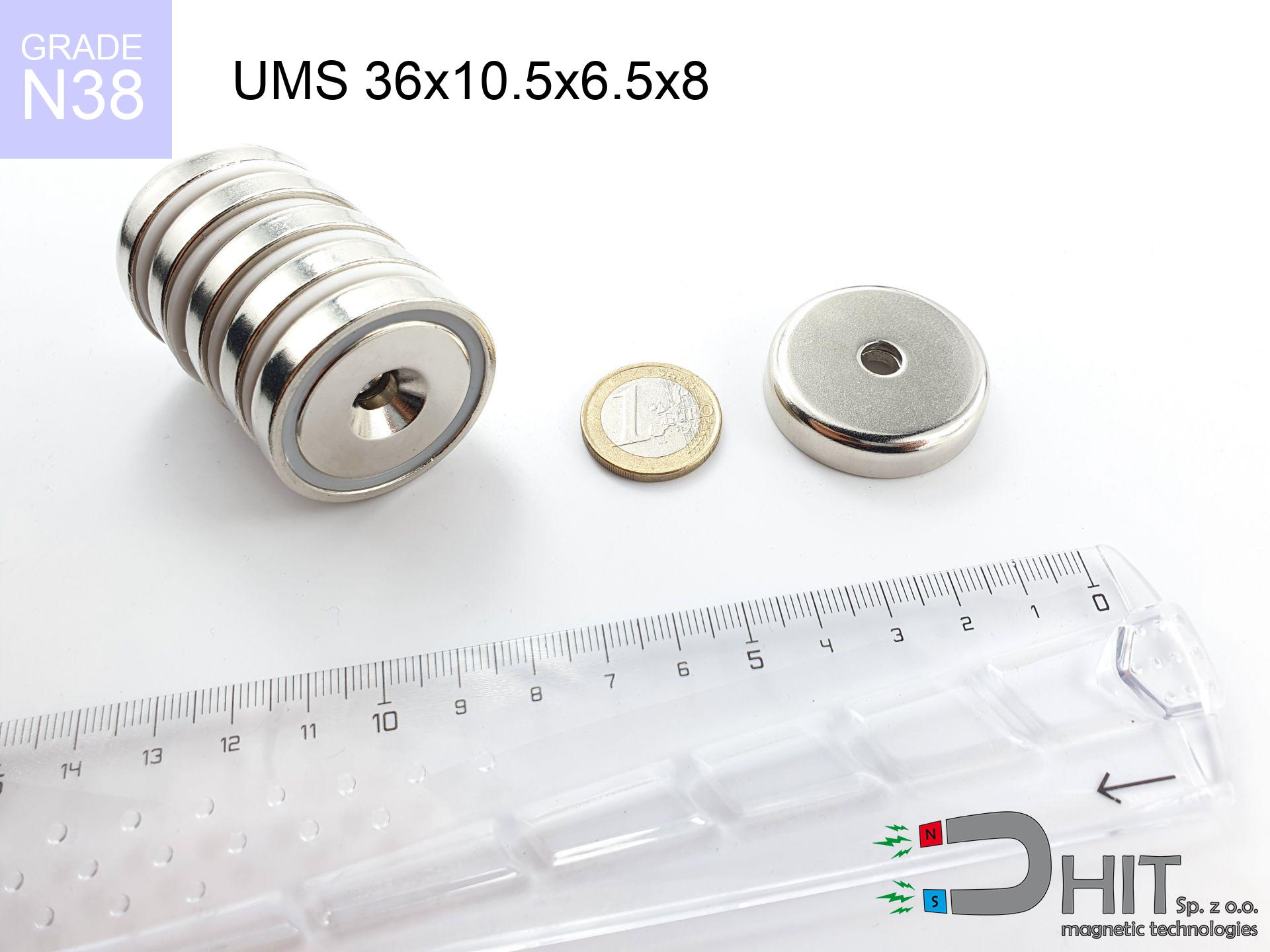MP 20x8x6 / N38 - ring magnet
ring magnet
Catalog no 030189
GTIN/EAN: 5906301812067
Diameter
20 mm [±0,1 mm]
internal diameter Ø
8 mm [±0,1 mm]
Height
6 mm [±0,1 mm]
Weight
11.88 g
Magnetization Direction
↑ axial
Load capacity
7.22 kg / 70.81 N
Magnetic Induction
318.85 mT / 3188 Gs
Coating
[NiCuNi] Nickel
5.17 ZŁ with VAT / pcs + price for transport
4.20 ZŁ net + 23% VAT / pcs
bulk discounts:
Need more?
Call us now
+48 22 499 98 98
alternatively contact us using
request form
the contact form page.
Weight along with shape of neodymium magnets can be tested on our
force calculator.
Same-day shipping for orders placed before 14:00.
Technical - MP 20x8x6 / N38 - ring magnet
Specification / characteristics - MP 20x8x6 / N38 - ring magnet
| properties | values |
|---|---|
| Cat. no. | 030189 |
| GTIN/EAN | 5906301812067 |
| Production/Distribution | Dhit sp. z o.o. |
| Country of origin | Poland / China / Germany |
| Customs code | 85059029 |
| Diameter | 20 mm [±0,1 mm] |
| internal diameter Ø | 8 mm [±0,1 mm] |
| Height | 6 mm [±0,1 mm] |
| Weight | 11.88 g |
| Magnetization Direction | ↑ axial |
| Load capacity ~ ? | 7.22 kg / 70.81 N |
| Magnetic Induction ~ ? | 318.85 mT / 3188 Gs |
| Coating | [NiCuNi] Nickel |
| Manufacturing Tolerance | ±0.1 mm |
Magnetic properties of material N38
| properties | values | units |
|---|---|---|
| remenance Br [min. - max.] ? | 12.2-12.6 | kGs |
| remenance Br [min. - max.] ? | 1220-1260 | mT |
| coercivity bHc ? | 10.8-11.5 | kOe |
| coercivity bHc ? | 860-915 | kA/m |
| actual internal force iHc | ≥ 12 | kOe |
| actual internal force iHc | ≥ 955 | kA/m |
| energy density [min. - max.] ? | 36-38 | BH max MGOe |
| energy density [min. - max.] ? | 287-303 | BH max KJ/m |
| max. temperature ? | ≤ 80 | °C |
Physical properties of sintered neodymium magnets Nd2Fe14B at 20°C
| properties | values | units |
|---|---|---|
| Vickers hardness | ≥550 | Hv |
| Density | ≥7.4 | g/cm3 |
| Curie Temperature TC | 312 - 380 | °C |
| Curie Temperature TF | 593 - 716 | °F |
| Specific resistance | 150 | μΩ⋅cm |
| Bending strength | 250 | MPa |
| Compressive strength | 1000~1100 | MPa |
| Thermal expansion parallel (∥) to orientation (M) | (3-4) x 10-6 | °C-1 |
| Thermal expansion perpendicular (⊥) to orientation (M) | -(1-3) x 10-6 | °C-1 |
| Young's modulus | 1.7 x 104 | kg/mm² |
Physical analysis of the assembly - data
The following information are the direct effect of a mathematical analysis. Values were calculated on models for the class Nd2Fe14B. Actual performance might slightly differ. Treat these calculations as a supplementary guide when designing systems.
Table 1: Static force (force vs gap) - interaction chart
MP 20x8x6 / N38
| Distance (mm) | Induction (Gauss) / mT | Pull Force (kg) | Risk Status |
|---|---|---|---|
| 0 mm |
5917 Gs
591.7 mT
|
7.22 kg / 7220.0 g
70.8 N
|
strong |
| 1 mm |
5321 Gs
532.1 mT
|
5.84 kg / 5839.8 g
57.3 N
|
strong |
| 2 mm |
4736 Gs
473.6 mT
|
4.63 kg / 4626.6 g
45.4 N
|
strong |
| 3 mm |
4184 Gs
418.4 mT
|
3.61 kg / 3610.0 g
35.4 N
|
strong |
| 5 mm |
3216 Gs
321.6 mT
|
2.13 kg / 2132.9 g
20.9 N
|
strong |
| 10 mm |
1650 Gs
165.0 mT
|
0.56 kg / 561.3 g
5.5 N
|
safe |
| 15 mm |
907 Gs
90.7 mT
|
0.17 kg / 169.7 g
1.7 N
|
safe |
| 20 mm |
544 Gs
54.4 mT
|
0.06 kg / 61.1 g
0.6 N
|
safe |
| 30 mm |
240 Gs
24.0 mT
|
0.01 kg / 11.9 g
0.1 N
|
safe |
| 50 mm |
75 Gs
7.5 mT
|
0.00 kg / 1.2 g
0.0 N
|
safe |
Table 2: Sliding load (vertical surface)
MP 20x8x6 / N38
| Distance (mm) | Friction coefficient | Pull Force (kg) |
|---|---|---|
| 0 mm | Stal (~0.2) |
1.44 kg / 1444.0 g
14.2 N
|
| 1 mm | Stal (~0.2) |
1.17 kg / 1168.0 g
11.5 N
|
| 2 mm | Stal (~0.2) |
0.93 kg / 926.0 g
9.1 N
|
| 3 mm | Stal (~0.2) |
0.72 kg / 722.0 g
7.1 N
|
| 5 mm | Stal (~0.2) |
0.43 kg / 426.0 g
4.2 N
|
| 10 mm | Stal (~0.2) |
0.11 kg / 112.0 g
1.1 N
|
| 15 mm | Stal (~0.2) |
0.03 kg / 34.0 g
0.3 N
|
| 20 mm | Stal (~0.2) |
0.01 kg / 12.0 g
0.1 N
|
| 30 mm | Stal (~0.2) |
0.00 kg / 2.0 g
0.0 N
|
| 50 mm | Stal (~0.2) |
0.00 kg / 0.0 g
0.0 N
|
Table 3: Wall mounting (shearing) - behavior on slippery surfaces
MP 20x8x6 / N38
| Surface type | Friction coefficient / % Mocy | Max load (kg) |
|---|---|---|
| Raw steel |
µ = 0.3
30% Nominalnej Siły
|
2.17 kg / 2166.0 g
21.2 N
|
| Painted steel (standard) |
µ = 0.2
20% Nominalnej Siły
|
1.44 kg / 1444.0 g
14.2 N
|
| Oily/slippery steel |
µ = 0.1
10% Nominalnej Siły
|
0.72 kg / 722.0 g
7.1 N
|
| Magnet with anti-slip rubber |
µ = 0.5
50% Nominalnej Siły
|
3.61 kg / 3610.0 g
35.4 N
|
Table 4: Material efficiency (saturation) - power losses
MP 20x8x6 / N38
| Steel thickness (mm) | % power | Real pull force (kg) |
|---|---|---|
| 0.5 mm |
|
0.72 kg / 722.0 g
7.1 N
|
| 1 mm |
|
1.81 kg / 1805.0 g
17.7 N
|
| 2 mm |
|
3.61 kg / 3610.0 g
35.4 N
|
| 5 mm |
|
7.22 kg / 7220.0 g
70.8 N
|
| 10 mm |
|
7.22 kg / 7220.0 g
70.8 N
|
Table 5: Working in heat (stability) - resistance threshold
MP 20x8x6 / N38
| Ambient temp. (°C) | Power loss | Remaining pull | Status |
|---|---|---|---|
| 20 °C | 0.0% |
7.22 kg / 7220.0 g
70.8 N
|
OK |
| 40 °C | -2.2% |
7.06 kg / 7061.2 g
69.3 N
|
OK |
| 60 °C | -4.4% |
6.90 kg / 6902.3 g
67.7 N
|
OK |
| 80 °C | -6.6% |
6.74 kg / 6743.5 g
66.2 N
|
|
| 100 °C | -28.8% |
5.14 kg / 5140.6 g
50.4 N
|
Table 6: Two magnets (repulsion) - field range
MP 20x8x6 / N38
| Gap (mm) | Attraction (kg) (N-S) | Repulsion (kg) (N-N) |
|---|---|---|
| 0 mm |
52.44 kg / 52443 g
514.5 N
6 121 Gs
|
N/A |
| 1 mm |
47.33 kg / 47332 g
464.3 N
11 242 Gs
|
42.60 kg / 42599 g
417.9 N
~0 Gs
|
| 2 mm |
42.42 kg / 42418 g
416.1 N
10 642 Gs
|
38.18 kg / 38176 g
374.5 N
~0 Gs
|
| 3 mm |
37.84 kg / 37837 g
371.2 N
10 051 Gs
|
34.05 kg / 34053 g
334.1 N
~0 Gs
|
| 5 mm |
29.73 kg / 29735 g
291.7 N
8 910 Gs
|
26.76 kg / 26761 g
262.5 N
~0 Gs
|
| 10 mm |
15.49 kg / 15493 g
152.0 N
6 432 Gs
|
13.94 kg / 13943 g
136.8 N
~0 Gs
|
| 20 mm |
4.08 kg / 4077 g
40.0 N
3 299 Gs
|
3.67 kg / 3669 g
36.0 N
~0 Gs
|
| 50 mm |
0.18 kg / 185 g
1.8 N
702 Gs
|
0.17 kg / 166 g
1.6 N
~0 Gs
|
Table 7: Protective zones (implants) - precautionary measures
MP 20x8x6 / N38
| Object / Device | Limit (Gauss) / mT | Safe distance |
|---|---|---|
| Pacemaker | 5 Gs (0.5 mT) | 14.5 cm |
| Hearing aid | 10 Gs (1.0 mT) | 11.5 cm |
| Mechanical watch | 20 Gs (2.0 mT) | 9.0 cm |
| Mobile device | 40 Gs (4.0 mT) | 6.5 cm |
| Remote | 50 Gs (5.0 mT) | 6.0 cm |
| Payment card | 400 Gs (40.0 mT) | 2.5 cm |
| HDD hard drive | 600 Gs (60.0 mT) | 2.0 cm |
Table 8: Dynamics (kinetic energy) - collision effects
MP 20x8x6 / N38
| Start from (mm) | Speed (km/h) | Energy (J) | Predicted outcome |
|---|---|---|---|
| 10 mm |
26.04 km/h
(7.23 m/s)
|
0.31 J | |
| 30 mm |
43.11 km/h
(11.97 m/s)
|
0.85 J | |
| 50 mm |
55.60 km/h
(15.44 m/s)
|
1.42 J | |
| 100 mm |
78.62 km/h
(21.84 m/s)
|
2.83 J |
Table 9: Coating parameters (durability)
MP 20x8x6 / N38
| Technical parameter | Value / Description |
|---|---|
| Coating type | [NiCuNi] Nickel |
| Layer structure | Nickel - Copper - Nickel |
| Layer thickness | 10-20 µm |
| Salt spray test (SST) ? | 24 h |
| Recommended environment | Indoors only (dry) |
Table 10: Electrical data (Pc)
MP 20x8x6 / N38
| Parameter | Value | SI Unit / Description |
|---|---|---|
| Magnetic Flux | 15 688 Mx | 156.9 µWb |
| Pc Coefficient | 1.14 | High (Stable) |
Table 11: Physics of underwater searching
MP 20x8x6 / N38
| Environment | Effective steel pull | Effect |
|---|---|---|
| Air (land) | 7.22 kg | Standard |
| Water (riverbed) |
8.27 kg
(+1.05 kg Buoyancy gain)
|
+14.5% |
1. Wall mount (shear)
*Warning: On a vertical surface, the magnet retains merely approx. 20-30% of its max power.
2. Steel saturation
*Thin steel (e.g. computer case) severely weakens the holding force.
3. Power loss vs temp
*For N38 grade, the critical limit is 80°C.
4. Demagnetization curve and operating point (B-H)
chart generated for the permeance coefficient Pc (Permeance Coefficient) = 1.14
This simulation demonstrates the magnetic stability of the selected magnet under specific geometric conditions. The solid red line represents the demagnetization curve (material potential), while the dashed blue line is the load line based on the magnet's geometry. The Pc (Permeance Coefficient), also known as the load line slope, is a dimensionless value that describes the relationship between the magnet's shape and its magnetic stability. The intersection of these two lines (the black dot) is the operating point — it determines the actual magnetic flux density generated by the magnet in this specific configuration. A higher Pc value means the magnet is more 'slender' (tall relative to its area), resulting in a higher operating point and better resistance to irreversible demagnetization caused by external fields or temperature. A value of 0.42 is relatively low (typical for flat magnets), meaning the operating point is closer to the 'knee' of the curve — caution is advised when operating at temperatures near the maximum limit to avoid strength loss.
Chemical composition
| iron (Fe) | 64% – 68% |
| neodymium (Nd) | 29% – 32% |
| boron (B) | 1.1% – 1.2% |
| dysprosium (Dy) | 0.5% – 2.0% |
| coating (Ni-Cu-Ni) | < 0.05% |
Environmental data
| recyclability (EoL) | 100% |
| recycled raw materials | ~10% (pre-cons) |
| carbon footprint | low / zredukowany |
| waste code (EWC) | 16 02 16 |
Check out also offers
Strengths and weaknesses of neodymium magnets.
Pros
- They retain magnetic properties for almost 10 years – the drop is just ~1% (according to analyses),
- They are extremely resistant to demagnetization induced by presence of other magnetic fields,
- By applying a decorative coating of nickel, the element gains an modern look,
- Magnets possess huge magnetic induction on the outer side,
- Made from properly selected components, these magnets show impressive resistance to high heat, enabling them to function (depending on their form) at temperatures up to 230°C and above...
- Thanks to flexibility in shaping and the capacity to adapt to complex applications,
- Wide application in innovative solutions – they are utilized in mass storage devices, electromotive mechanisms, diagnostic systems, as well as technologically advanced constructions.
- Thanks to concentrated force, small magnets offer high operating force, in miniature format,
Cons
- They are prone to damage upon heavy impacts. To avoid cracks, it is worth protecting magnets in special housings. Such protection not only protects the magnet but also improves its resistance to damage
- When exposed to high temperature, neodymium magnets suffer a drop in strength. Often, when the temperature exceeds 80°C, their power decreases (depending on the size and shape of the magnet). For those who need magnets for extreme conditions, we offer [AH] versions withstanding up to 230°C
- When exposed to humidity, magnets usually rust. For applications outside, it is recommended to use protective magnets, such as magnets in rubber or plastics, which secure oxidation as well as corrosion.
- Due to limitations in realizing threads and complicated shapes in magnets, we propose using a housing - magnetic mechanism.
- Health risk to health – tiny shards of magnets are risky, in case of ingestion, which is particularly important in the aspect of protecting the youngest. Additionally, small elements of these magnets can disrupt the diagnostic process medical after entering the body.
- Higher cost of purchase is one of the disadvantages compared to ceramic magnets, especially in budget applications
Holding force characteristics
Optimal lifting capacity of a neodymium magnet – what affects it?
- using a sheet made of low-carbon steel, functioning as a magnetic yoke
- whose thickness is min. 10 mm
- with a plane free of scratches
- without the slightest air gap between the magnet and steel
- for force applied at a right angle (in the magnet axis)
- at ambient temperature approx. 20 degrees Celsius
Lifting capacity in real conditions – factors
- Distance – existence of foreign body (paint, tape, air) interrupts the magnetic circuit, which lowers capacity steeply (even by 50% at 0.5 mm).
- Loading method – declared lifting capacity refers to detachment vertically. When attempting to slide, the magnet exhibits significantly lower power (often approx. 20-30% of maximum force).
- Substrate thickness – to utilize 100% power, the steel must be adequately massive. Paper-thin metal restricts the attraction force (the magnet "punches through" it).
- Material composition – different alloys reacts the same. Alloy additives worsen the attraction effect.
- Base smoothness – the smoother and more polished the surface, the better the adhesion and higher the lifting capacity. Unevenness acts like micro-gaps.
- Temperature – temperature increase results in weakening of induction. It is worth remembering the thermal limit for a given model.
Holding force was checked on a smooth steel plate of 20 mm thickness, when the force acted perpendicularly, in contrast under attempts to slide the magnet the holding force is lower. Additionally, even a small distance between the magnet and the plate decreases the lifting capacity.
Warnings
Life threat
Warning for patients: Strong magnetic fields affect electronics. Keep minimum 30 cm distance or request help to work with the magnets.
Do not drill into magnets
Powder produced during grinding of magnets is combustible. Avoid drilling into magnets without proper cooling and knowledge.
Adults only
Neodymium magnets are not suitable for play. Eating a few magnets can lead to them pinching intestinal walls, which poses a critical condition and necessitates immediate surgery.
Crushing risk
Risk of injury: The pulling power is so great that it can cause hematomas, pinching, and even bone fractures. Use thick gloves.
Data carriers
Intense magnetic fields can erase data on payment cards, HDDs, and other magnetic media. Keep a distance of at least 10 cm.
Warning for allergy sufferers
It is widely known that nickel (standard magnet coating) is a potent allergen. If you have an allergy, avoid touching magnets with bare hands and select encased magnets.
Beware of splinters
NdFeB magnets are sintered ceramics, meaning they are very brittle. Impact of two magnets will cause them breaking into small pieces.
GPS Danger
A powerful magnetic field interferes with the operation of compasses in phones and GPS navigation. Do not bring magnets near a smartphone to prevent breaking the sensors.
Do not underestimate power
Be careful. Rare earth magnets act from a long distance and connect with massive power, often faster than you can move away.
Permanent damage
Avoid heat. NdFeB magnets are susceptible to heat. If you require resistance above 80°C, ask us about special high-temperature series (H, SH, UH).


